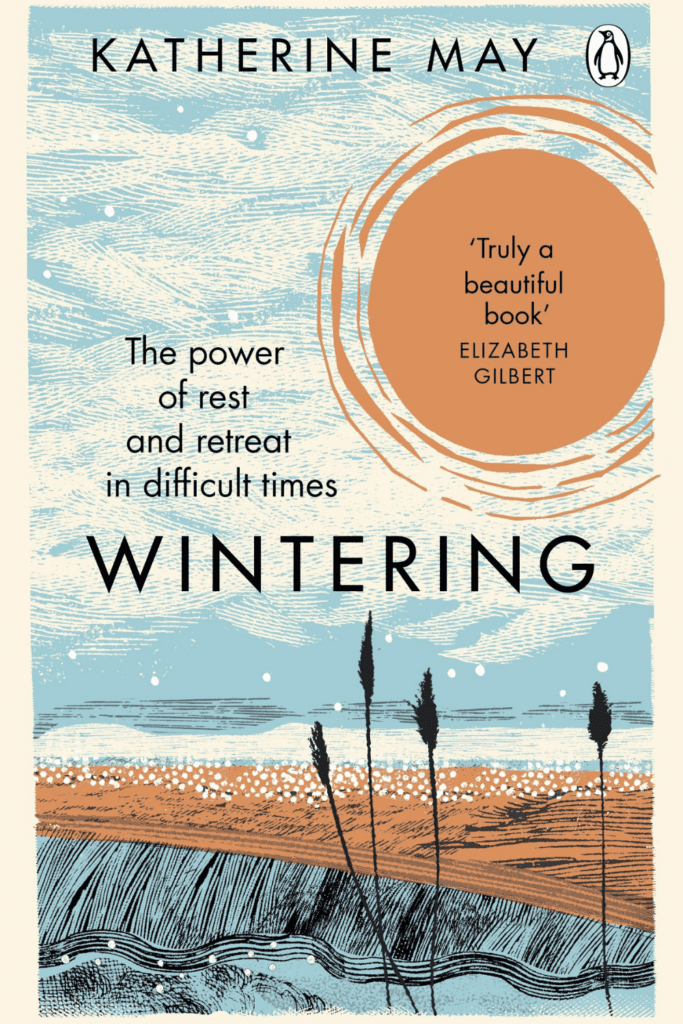This post may contain affiliate links, which means I’ll receive a commission if you purchase through my links, at no extra cost to you. Please read my full disclosure for more information.
“Wintering” is Katherine May’s intimate and personal narrative of how unforeseen circumstances have allowed her to unlock the transformative power of rest and retreat during a difficult time she calls wintering.
- Date finished: February 9th, 2025
- Pages: 241
- Format: Hardback
- Form: Non-Fiction
- Language read: English
- Series: Standalone
- Genre: Non-Fiction | Memoir | Self-Help
Buy “Wintering”
At the centre of “Wintering” is an extensive metaphor likening the winter season to life’s hardships, its ups and downs, as well as our need to rest, retreat, and rejuvenate during our “personal winters.”

From the picture above, you can see that I read “Wintering” at the ideal time, precisely amid a week of snowstorms in the middle of February. I have a vlog highlighting my experience of that week, you can watch it here.
This book struck a chord for me as I have just slowly transitioned out of my wintering period, and have found that I can view my experiences fondly — with less perceived shame and greater wisdom. After all, Katherine May reminds us that “Everybody winters at one time or another; some winter over and over again.” (p. 10) And not only so, “However it arrives, wintering is usually involuntary, lonely, and deeply painful. Yet it’s also inevitable.” (p. 11) These words spoke straight to my heart, soothing my soul after a period of self-imposed isolation to heal, rest, and recover from a decade’s battle with addiction and self-harm.
Also, as someone who suffered another year with insomnia, this book is a revelatory gift to read. I truly believe rest and subsequently sleep are both useful and a tool of resistance to our capitalist society:
There is not enough night left for us. We have lost our true instincts for darkness, its invitation to spend some time in the proximity of our dreams. Our personal winters are so often accompanied by insomnia: perhaps we’re drawn towards that unique space of intimacy and contemplation, darkness and silence, without really knowing what we’re seeking. Perhaps, after all, we are being urged towards our own comfort.
Sleep is not a dead space, but a doorway to a different kind of consciousness—one that is reflective and restorative, full of tangential thought and unexpected insights. In winter, we are invited into a particular mode of sleep: not a regimented eight hours, but a slow, ambulatory process in which waking thoughts merge with dreams, and space is made in the blackest hours to repair the fragmented narratives of our days.
Yet we are pushing away this innate skill we have for digesting the difficult parts of life. My own midnight terrors vanish when I turn insomnia into a watch: a claimed sacred space in which I have nothing to do but contemplate. Here, I am offered a place in between, like finding a hidden door, the stuff of dreams. Even dormice know how to do it: they wake a while and tend to business before surrendering back to sleep.
Over and again, we find that winter offers us liminal spaces to inhabit. Yet still we refuse them. The work of the cold season is to learn to welcome them. pp. 87-88
Furthermore, this book surveys, beautifully (yes, I’m repeating myself!), the months of September to Late March. And it is a book I look forward to revisiting during those months. Although always centered on the act of ‘wintering,’ the subjects and discoveries vary depending the specific month.
For example, for October, Katherine May gravitates towards Halloween (Samhain) and our fascination with ghosts, consider the following passages:
In Halloween, we see echoes of the Gaelic pagan festival of Samhain, which marked the arrival of the “dark half” of the year. It was celebrated with bonfires and burning torches, the scattering of ashes and attempts to see the future through dreams or the flight of crows. Samhain was considered to be a moment when the veil between this world and the otherworld was at its thinnest. Old gods had to be placated with gifts and sacrifice, and the trickery of fairies was an even greater risk than usual. This was a liminal moment in the calendar, a time between two worlds, between two phases of the year, when worshippers were about to cross a boundary but hadn’t yet done so. Samhain was a way of marking that ambiguous moment when you didn’t know who you were about to become, or what the future would hold. It was a celebration of limbo. p. 56
Our contemporary Western celebrations forget the dead altogether, or at least remove them from any association with grief and loss. They offer no comfort to those who mourn. We are, after all, a society that has done all it can to erase death, to pursue youth to the bitter end, and to sideline the elderly and infirm. For most of us, the old tradition of laying out our own dead is long forgotten, and the idea that we might be intimate with death is now some kind of a gothic joke. Today’s Halloween simply reflects what we secretly think—that death is a surrender to decay that makes us monsters.
But winter is a time when death comes closest—when the cold feels as though it might yet snatch us away, despite our modern comforts. We still perceive the presence of those we’ve lost in the silence of those long evenings and in the depths of darkness that they bring. This is the season of ghosts. Their pale forms are invisible in bright sunlight. Winter makes them clear again. pp. 56-57
Ghosts may be a part of the terror of Halloween, but our love of ghost stories betrays a far more fragile desire: that we do not fade so easily from this life. We spend a lot of time talking about leaving a legacy in this world, grand or small, financial or reputational, so that we won’t be forgotten. But ghost stories show us a different concern, hidden under our bluster: we hope that the dead won’t forget us. We hope that we, the living, will not lose the meanings that seem to evaporate when our loved ones die. p. 59
Additionally, I’ve learned a lot about different traditions, deities, folklore, and mythology (Which I love!), and the author does a great job of tying everything back to the importance of rest and retreat in difficult times. Here are a few passages I highlighted on the deity of Cailleach:
Transformation is the business of winter. In Gaelic mythology, the hag deity known as the Cailleach takes human form at Samhain to rule the winter months, bringing with her winds and wild weather. Her very steps change the land: the mountains of Scotland were formed when she dropped rocks from her basket, and she carries a hammer for forming valleys.
A touch of her staff is enough to freeze the ground. p. 67
As we so often find in ancient folklore, the Cailleach offers us a cyclical metaphor for life, one in which the energies of spring arrive again and again, nurtured by the deep retreat of winter. We are no longer accustomed to thinking in this way.
Instead we are in the habit of imagining our lives to be linear, a long march from birth to death in which we mass our powers, only to surrender them again, all the while slowly losing our youthful beauty. This is a brutal untruth. Life meanders like a path through the woods. We have seasons when we flourish and seasons when the leaves fall from us, revealing our bare bones. Given time, they grow again. p. 68
A few of more of my favourite passages involve:
- learning that the Blue Lagoon is a “pool created by the runoff from a geothermal plant” (pp. 36-37)
- learning about St. Lucy’s Day and the festival of light (p. 93)
- learning about Stonehenge and the Druids of Celtic mythology (p. 103)
- learning wolves persistence, despite human cruel efforts to ‘chase’ them away (pp. 154-156)
Katherine May’s writing on her experiences of ‘wintering’ is breathtakingly raw and beautiful. The following passages are winter-related words of beauty, inspiration, and resilience that I’d love to share:
A surprising cluster of novels and fairy tales are set in the snow. Our knowledge of winter is a fragment of childhood, almost innate. All the careful preparations that animals make to endure the cold, foodless months; hibernation and migration, deciduous trees dropping leaves. This is no accident. The changes that take place in winter are a kind of alchemy, an enchantment performed by ordinary creatures to survive. Dormice laying on fat to hibernate, swallows navigating to South Africa, trees blazing out the final weeks of autumn. It is all very well to survive the abundant months of the spring and summer, but in winter, we witness the full glory of nature’s flourishing in lean times. p. 13
The ego flares like a struck match: bright, blue, fleeting. I am thankful to be alone when this happens, to let it burn out in private. We should sometimes be grateful for the solitude of night, of a winter. They save us from displaying our worst selves to the waking world. p. 79
But if happiness is a skill, then sadness is, too. Perhaps through all those years at school, or perhaps through other terrors, we are taught to ignore sadness, to stuff it down into our satchels and pretend it isn’t there. As adults, we often have to learn to hear the clarity of its call. That is wintering. It is the active acceptance of sadness. It is the practice of allowing ourselves to feel it as a need. It is the courage to stare down the worst parts of our experience and to commit to healing them the best we can. Wintering is a moment of intuition, our true needs felt keenly as a knife. pp. 119-120
Here is another truth about wintering: you’ll find wisdom in your winter, and once it’s over, it’s your responsibility to pass it on. And in return, it’s our responsibility to listen to those who have wintered before us. It’s an exchange of gifts in which nobody loses out. This may involve the breaking of a lifelong habit, one passed down carefully through generations: that of looking at other people’s misfortunes and feeling certain that they brought them upon themselves in a way that you never would. This isn’t just an unkind attitude. It does us harm, because it keeps us from learning that disasters do indeed happen and how we can adapt when they do. It stops us from reaching out to those who are suffering. And when our own disaster comes, it forces us into a humiliated retreat, as we try to hunt down mistakes that we never made in the first place or wrongheaded attitudes that we never held. Either that, or we become certain that there must be someone out there we can blame. Watching winter and really listening to its messages, we learn that effect is often disproportionate to cause; that tiny mistakes can lead to huge disasters; that life is often bloody unfair, but it carries on happening with or without our consent. We learn to look more kindly on other people’s crises, because they are so often portents of our own future. pp. 122-123
In the depths of our winters, we are all wolfish. We want in the archaic sense of the word, as if we are lacking something and need to absorb it in order to be whole again. These wants are often astonishingly inaccurate: drugs and alcohol, which poison instead of reintegrate; relationships with people who do not make us feel safe or loved; objects that we do not need, cannot afford, which hang around our necks like albatrosses of debt long after the yearning for them has passed. Underneath this chaos and clutter lies a longing for more elemental things—love, beauty, comfort, a short spell of oblivion once in a while. Everyday life is so often isolated, dreary, and lonely. A little craving is understandable. A little craving might actually be the rallying cry of survival. pp. 158-159
We must test the air and be ready to shrink back into safety when blasted by unseasonal winds; we must gradually unfurl our new leaves. There will still be the debris of a long, disordered season. These are the moments when we have to find the most grace: when we come to atone for the worst ravages of our conduct in darker times, when we have to tell truths that we’d rather ignore. Sometimes we will have to name our personal winters, and the words will feel barbed in our throats: grief, rejection, depression, illness. Shame, failure, despair.
It often seems easier to stay in winter, burrowed down into our hibernation nests, away from the glare of the sun. But we are brave, and the new world awaits us, gleaming and green, alive with the beat of wings. And besides, we have a kind of gospel to tell now, and a duty to share it. We, who have wintered, have learned some things.
We sing it out like birds. We let our voices fill the air. p. 241
Winter opens up time. “[There is nothing doing,” as Sylvia Plath notes in her poem “Wintering.” “This is the time of hanging on for the bees,” she says, having collected their honey. It’s now lined up in jars—six of them—on a shelf in her cellar, while they feed on sugar syrup. In the emptiness that winter brings, Plath huddles in her basement, picking out the leftover possessions of former tenants in her yellow torchlight and finding only “Black asininity. Decay. / Possession.”
She wonders if the hive will survive.
Plath, as every schoolgirl knows, did not survive her winter.
She wrote “Wintering” towards the end of her life, and it marked the end of her own draft of Ariel, her iconic collection of love and despair, hope and loss, before it was reedited for publication by her husband, Ted Hughes, after her suicide.
“Wintering” takes us into the depths of darkness, in the depths of the house, “the black bunched in there like a bat.” I always find it a difficult poem to read. Its syntax never sits quite right to my eye. Its sentences meander across lines and stanzas; its meanings blur. In it, I find a kind of disorder, as though we find ourselves dropped into the middle of a thought process whose beginning and end we can’t perceive. pp. 210-211
I have often heard talk of the nostalgia of snow, the way that we always imagine our childhoods to have been snowier than they actually were. p. 163
Snow creates that quality of awe in the face of a power greater than ours. It epitomises the aesthetic notion of the sublime, in which greatness and beauty couple to overcome you—a small, frail human—entirely. p. 165
⭐⭐⭐⭐⭐⭐







Leave a Reply